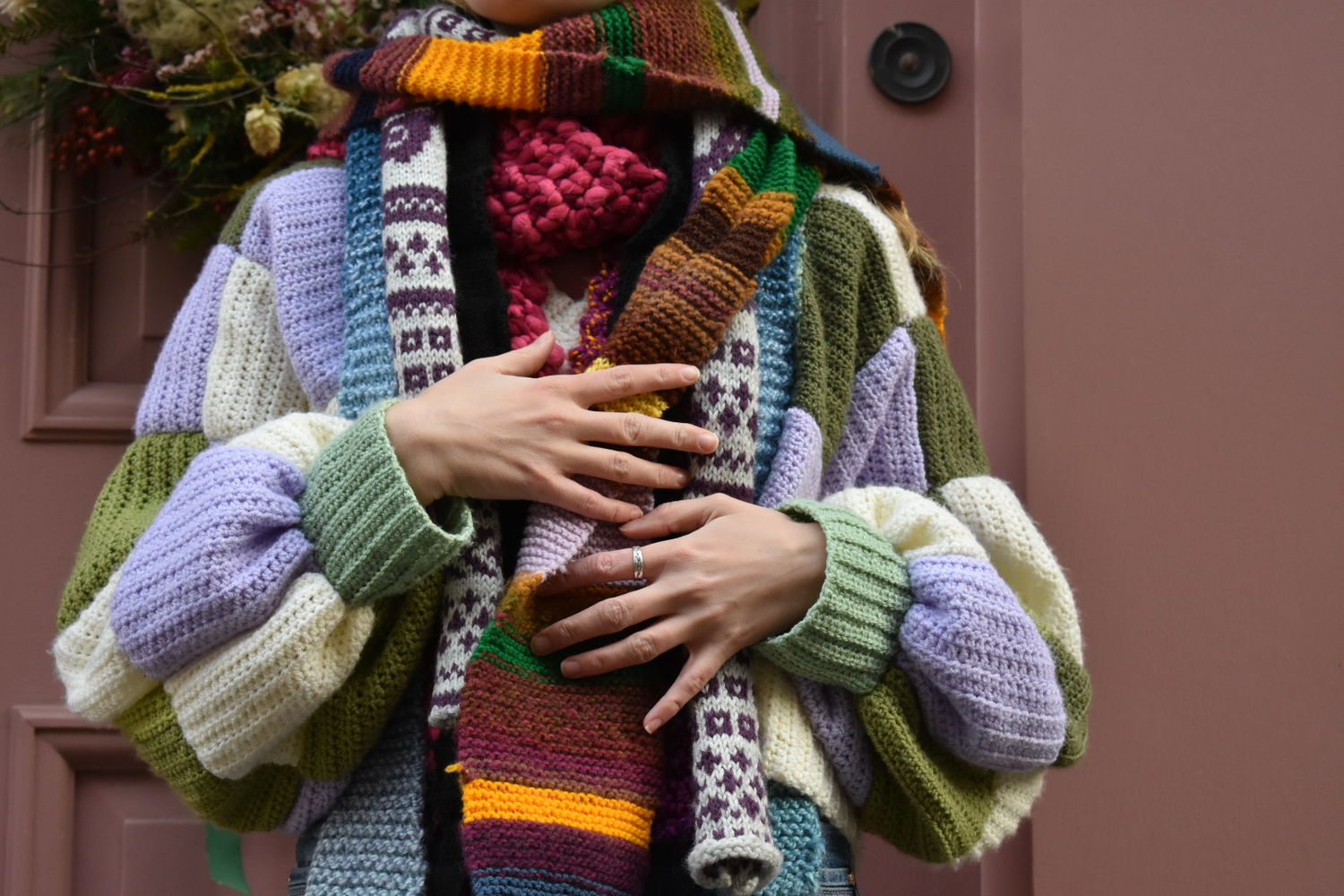When I learnt to knit, fashion was the furthest thing from my mind. At the age of eight, knitting, as far as I was aware, was about making blankets for dolls, and uncomfortable hats for babies. My lack of patience did not help, and the thought of making something large enough to fit an (adult) human seemed completely out of reach. Fortunately for me, I had a very sensible grandmother teaching me to knit who gave me lots of breaks, meaning that I never got too frustrated with the craft.
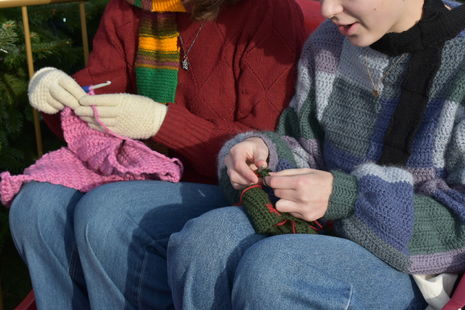
As I began to get more comfortable with the motion of knitting, my projects slowly began to get more practical. The repetitive action of creating stitches can be very calming; after a long day staring at a screen, it feels good to create something with your hands. Perhaps that is why Generation Z have been drawn to the craft in recent years. In a sterile, digital world, knitting and crochet are wonderfully tactile; the sound of metal needles against one another, the texture and colour of each different wool, the feeling of gently pulling on your half-finished work to try and even out the stitches. It all provides a very pleasant break from the world of screens.
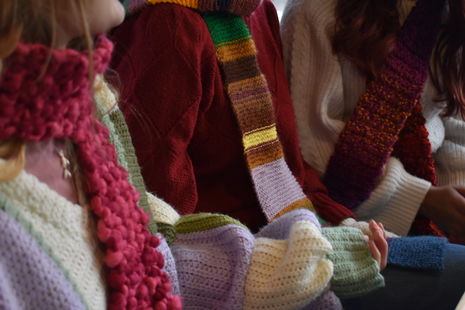
Cambridge is one of those lovely places where knitting in public is not uncommon. I have become quite shameless when it comes to knitting in public, often pulling out a project while alone at a café, or during study breaks in the library. The act of creating a garment slowly and painstakingly imbues every finished piece with an extra bit of love. With the popularity of fast-fashion knitwear, it is easy to forget how long it can take to make these items. Creating something by hand reminds you that everything we wear at this time of year was knitted or crocheted by someone, somewhere out there in the world, whether by hand or operating a machine. And here’s a not-fun fact for you – industrial crochet machines don’t exist. Anything crocheted has to be made by hand. Once you add up how long it takes to make something like that, and compare how little the finished garment costs the consumer, fast fashion knitwear does not feel so Christmassy after all.
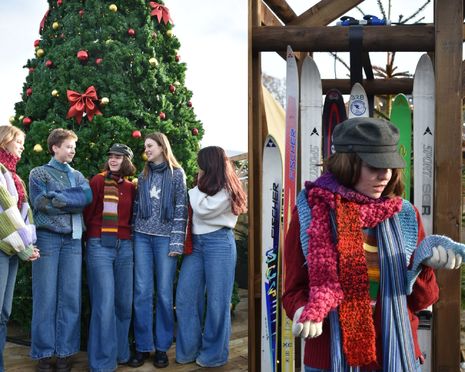
Now that we’ve glanced briefly at the sour sprout that is the fast fashion industry, let’s get back to talking about cool clothes. For this shoot, I wanted to highlight students whose hobbies and style are intertwined, with winter being the perfect opportunity for these students to bring a range of one-of-a-kind pieces from their wardrobe and onto the streets of Cambridge.
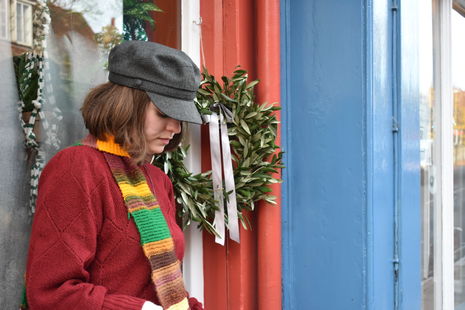
This multicoloured scarf is one I made last year. In my ever expanding hoard of wool, I had accumulated many leftovers, so to speak, from other projects. Without much use for them, and wanting to have a bit of a clear-out, I decided to knit a scarf that incorporated all my different remnants of wool, while still remaining fairly cohesive. Luckily, a lot of my hoard was of a similar thickness; for knitting, I find narrower wool much easier to work with. For crochet I prefer thicker wool, which has the advantage of making projects much faster. Therefore, a lot of my remnants fell within one of the two size brackets. I alternated the colourful remnants with a neutral brownish-purple wool which I was gifted a few years ago, and the effect seems to have worked. It gets a lot of use at this time of year, although because I wear a lot of patterned clothing, the addition of a patterned scarf on top can look a bit too busy. I’m a firm believer in the rule of one pattern per outfit, except in exceptional circumstances. The addition of a scarf can be useful, however, to add something that is missing to an outfit – whether that be a pattern, a texture, or a colour contrast. In this outfit, for example, I’m wearing a lot of block colours so a patterned scarf adds a little bit of dimension to the look.
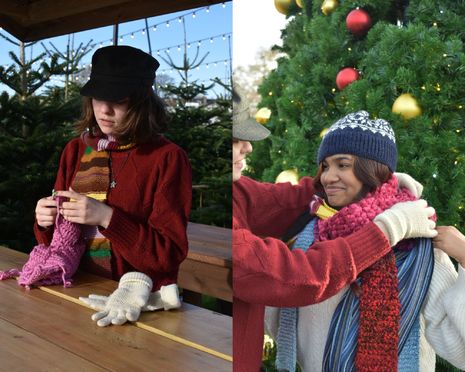
Something I enjoy about knitting and crochet is the opportunity to make handmade gifts for people. Maithri, my college wife, recently received a scarf from me that I promised her for her birthday. I must acknowledge that her Birthday was in February – but better late than never! Sometimes, with procrastination and delays on projects, it can be more efficient to gift someone an I.O.U. than an actual item. Maithri didn’t seem to mind, saying: “I like homemade knitwear because it gives very homely, cosy vibes. It feels very special – because they’ve put the effort in to knit that specifically for me. My Michaelmas fashion vibe is very much based on lots of jumpers, boots, trench coats – so it fits right in.”
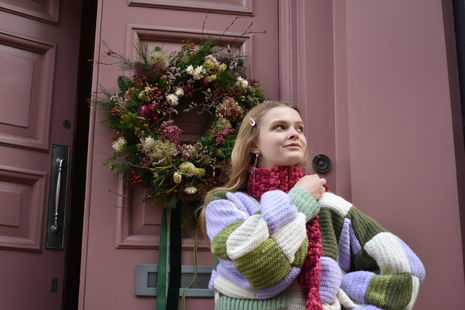
However, Magdalena has me beaten on the procrastination front. Her cardigan was a 2020 lockdown project which was finally completed this year. As she pointed out, “It took me less time to get a degree than finish it!”. Once she was in the flow of it, though, there was no stopping her and she made a sweater vest start-to-finish within a week of completing the cardigan. Knitting and crochet works on its own timeline, and sometimes unfinished projects just need a little bit of time in the drawer before they are ready to be finished and brought to life.
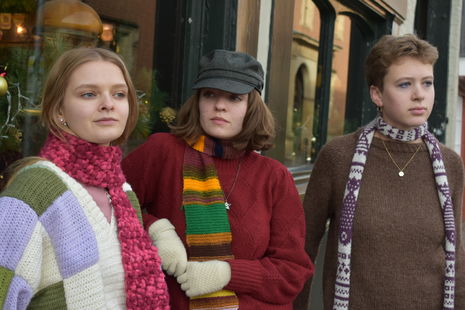
Olive (pictured above) also loved the cosiness of knitwear, and stressed the importance of material in order to achieve this. For her Fair Isle fish knit scarf she turned to Norwegian wool, whereas it is the alpaca and wool blend in her brown jumper that makes it so comforting. Of the project, she said that “It was my first ever knit project, made during Lent term last year. I love the shape and it taught me so many essential techniques.” She also mentioned the fun of collecting “different skeins of yarn from yarn shops all over the UK”, and combining them for a “mismatched” look. Knitting is also more than an aesthetic pursuit; Olive noted that a “stress relief project” was especially important to her during her A Levels.
If you’re looking to get into knitting or crochet this Christmas season, YouTube has a ton of great tutorials to get you started. You can follow step-by-step guides to make specific projects, or if you are feeling more ambitious, once you have mastered the basic techniques you can try coming up with your own designs. The important thing to remember is to be patient and give yourself breaks if you are getting frustrated. These skills take time to develop, and with a little perseverance, you’ll be knitting with the best of them.

